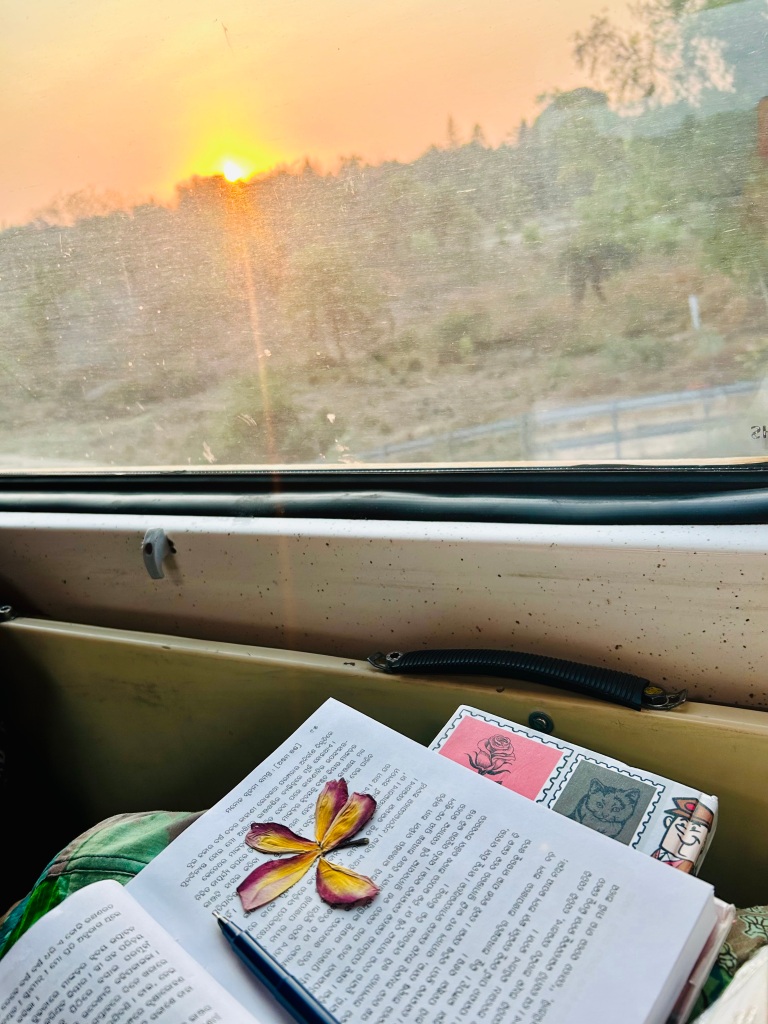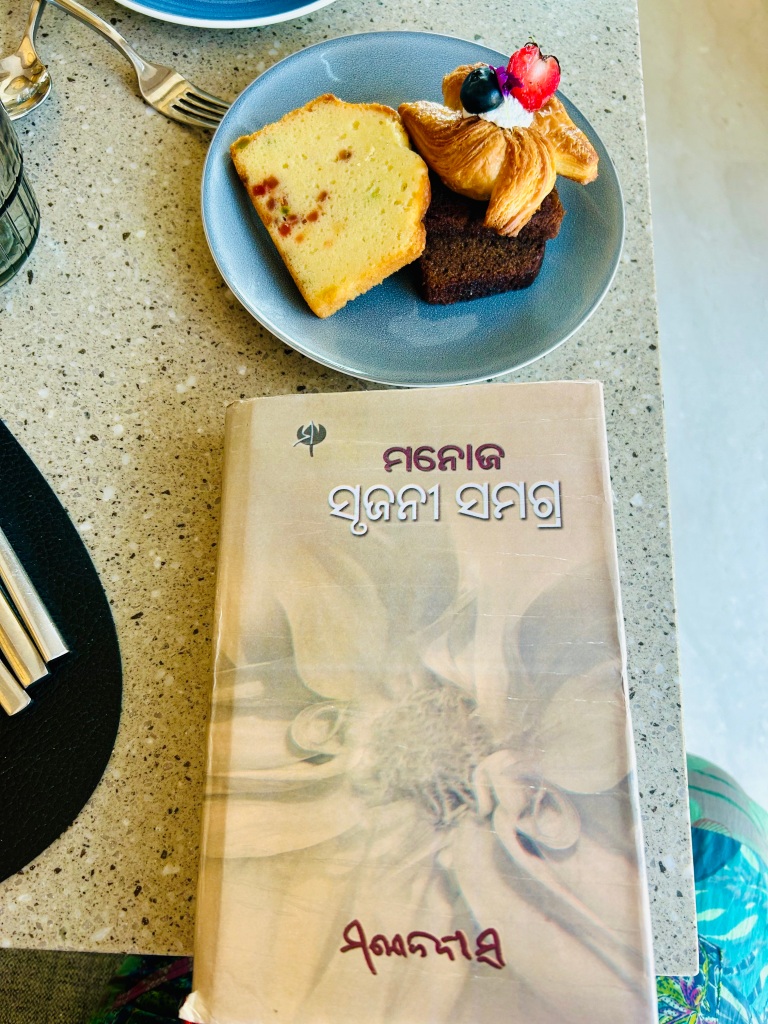This book is my third Odia book this year. It has been a great experience to reconnect with my own language. As I have mentioned in many places my favourite Odia writer is Manoj Das. By the way, he has written in English too, in case you can’t read Odia.
There are books and there are books. There are millions of brilliant books in this world, however there are only handful which are just for “you”. Each year I read a lot of writers but there are only handful writers whose fictional world I crave to go to again and again.

Along Milan Kundera and Haruki Murakami, Manoj Das is among those handful writers. I am not saying they are the best. I am saying I feel like I belong to the world they create with their words. And also for me personally, they are the best.
On my recent visit to Odisha, I bought two omnibuses by Manoj Das. The book Samudra Kulara Eka Graama (One Village on the Shore of Sea) is part of one of these two (the 8th part). This book is a collection of 25 short works. These are not fictional short stories but slice of life pieces from the writer’s childhood days.
The writer was born in the year 1934 in a small village named Shankhari in the Balasore district of Odisha. He spent a happy and surprisingly eventful childhood in this village, which is on the coast. According to him, we have faced a kind of development in last decades where we have lost the innocence of village life.

In the beginning of the book, he has written the pieces don’t follow any chronological order. His reminiscences are absolute truth. All dramatic things really happened in his childhood. He has only changed names of many people.
These pieces are originally written in English. These were published as columns in various special editions of English Daily The Statesman. The pieces were collected and published later as a book in English language, “Chasing the Rainbow: Growing Up in an Indian Village”.
The speciality of Odia version is the sketches in the book by Mr. Shishir Dutt.
THE PIECES
1. Dui Sarovara (Two Lakes)
He gives a brief information about his family background and about his village Shankhari. It is obvious he is in love with both his family and his village. He is the pampered youngest child among five siblings. But however secure a child might be, they have to come face to face with death.
It is common in Odisha to have origin story behind hills, water bodies etc. There are two adjacent lakes in his village. The backstory involves tragic deaths of lovers.
2. Pravanjana ra Padachinha (Footprints of Hurricane)
Natural disasters are old friends of coastal Odisha. This piece gives a heart-wrenching picture of a hurricane and its aftermath. His family helps out people in this difficult time. The writer suffers from small pox.
3. Bibhishikamaya Dui Rajani (The Horror of Two Nights)
In those pre-bank and pre-reliable investment avenues era, people used to keep money and other valuables in their home. The rich people had proper almirah or even special rooms to keep their treasure securely. Some used to even bury their treasure. These used to make them susceptible to looting.
The writer’s family fell victim to armed robbery not once but twice. They not only lost a lot, they got traumatised too. In the end, the robber group got caught.
4. Eka Jalajatra: Eka Sajala Sanja (One Water Travel: One Watery Evening)
Writer’s family went by water to the city where the robbers were prosecuted to give their statements as witnesses. The depiction of the journey is beautiful. They had to stop somewhere due to lack of wind. In the village the writer befriends a girl. And there he came face to face with the other side. The village was the village of the robbers. The girl’s father is arrested like many other fathers in the village. They are obviously not happy about it.
5. ‘U’ Saha Eka Godhuli (One Evening with ‘U’)
In Odia, evening is generally called Sandhya or Sanja. Godhuli is an old word used for evening. It literally means Cow Dust. In old days cow herds used to take cattle for grazing in the morning and come back in the evening. When they used to come back in the evening, with their hoofs combinedly walking creates dust all around. Hence the name Godhuli. This is one of those beautiful words, not in use anymore.
‘U’ is one of those imaginary monsters created by elders to scare children to stay out of trouble. Montu was quite scared of ‘U’ yet his inquisitiveness overcomes his fear most of the time. Once he went away to an unfamiliar place to find the end part of rainbow.
6. Bidyarambha (Beginning of Education)
Montu detests formal education. He was not willing to start his education in the village school. But then he establishes a tender connection with the headmaster. The fear of/sadness from losing mother can create connection going beyond age.
7. Kimbadanti ra Kantha (The Voice of Folklore)
A visit to Jagannath Puri was the ultimate experience in the life of any Odia. Montu travels to Puri and visits the temple with his mother.
8. Anutapta Dian (Regretful God)
For government run schools the higher officials are God-like. The teachers work over time to make them happy on their inspection visits. One such visit, Montu’s bunking school, and Montu meeting someone who talks to God, and in the end the mother comes back from her visit to her brother.
9. Antahrita Paadaanguli ra Rahasya (The Mystery of the Vanished Toe)
In those days girls used to get married very early. A thirteen/fourteen year old girl was suddenly thrown out of her childhood and her home to a stranger’s home. She was at their mercy. If they are good people then fine or it is better not to write what these young girls have to go through. Writer has given an anguishing picture of this through his sister’s anxiety about her upcoming wedding.
10. Bhishana Saha Bandhuta (Friendship with Horror)
A sad story of struggle between man and tiger, or a pregnant tigress in this case. The writer kept the new born cub for few days as his loving pet.
11. Paagali (Mad Woman)
A mad woman with some sad back story was being teased and harassed by everyone except the writer’s wife, who is a personification of kindness.
12. Hatya (Murder)
This piece is about a struggle between men and a group of monkeys led by a tailless money straight out of Panchatantra (according to the writer at least).
13. Shesha Bali (Last Sacrifice)
The last remains of an ancient curse
14. Haladi-Basani Jhiati (The Girl in Yellow Dress)
Beautiful memories of hostel days with some ghost stories
15. Bismruta Dhoopa ra Mahaka (Fragrance of the Forgotten Incense Stick)
The writer goes to his Uncle (Mamaji’s) place in southern Odisha (Gunapur). There he meets many characters including one butcher. He takes him to a Goddess’s worship place. The writer lights his first incense stick there. The memory comes back when he goes to Shri Arabinda’s ashram for the first time. It is a common knowledge Manoj Das was devoted to Shri Arabinda and Shri Maa. He was settled in Pondicherry.
16. Eka Godhuli O Dui Nishardha (One Evening and Two Midnights)
A fire near Bansadhara river in Gunapur and kindness of the writer’s mother towards a lonely old lady
17. Ketoti Sandhya ra Jubaraj (Crown Prince of Few Evenings)
Another friend in Gunapur, who claims to be the crown prince of the place
18. Nai Sepaari ra Rajya (Kingdom on the other side of the River)
Writer’s interaction with his poor Muslim classmate and his family, who lived in a ghetto on the other side of Subarnarekha river.
19. Eka Aparaanha ra Duhswapna (Nightmare of an Afternoon)
In the midst of Second World War one fighter plane falls near the writer’s school. The pilot was alive. An unbelievable experience!
20. Baalupraantara Upare Swadhinataa ra Surjyodaya (Sunrise of Independence above the Land of Sands)
The writer and his school friends celebrate independence of India
21. Chetana Rajya ra Rajakanya (Princess of the Mythical Land)
Writer’s father starts a travelling drama company. Writer used to sing some time in the dramas. Mostly they enact Vaishnavite dramas in Bengali. Writer belongs to Balasore district, which borders to Bengal. Most people know to speak and read Bengali.
An old woman thinks the Radha Krishna of the Drama are real. The writer was touched by her simplicity and belief.
22. Dui Palli-Purusha (Two village persons)
This piece is about the grandparents of the writer. All of them led unbelievably extraordinary lives.
23.Sankshepita Mahaabala (Shrunk
A mythical vegetarian tiger of the Goddess
24. Kalikata-Darshana (Kolkata
The ultimate coming of age for the young adults of the writer’s village is going to Kolkata. It is the nearest Metropolitan city and also this place makes a “man” out of even grown men. The writer’s family including his father have faced conning and stealing at various points. Writer has depicted each mishap quite hilariously.
25. “Gachha Tu Kahniki Malu!” (“Tree, Why Did You Die!”)
A sad encounter with an unfortunate girl
MY TWO PENNIES
My briefings have in no way have done justice to the vivid description of the village life, the wit, the clever use of language, and the emotions. One has to read the book to experience them.
These pieces might remind the readers about Rusty series of Ruskin Bond. That is true to an extent I would say. But there are some deeper layers in Manoj Das’s works. Apart from that, while Rusty was eternally the outsider Montu was in the middle of everything along his family.
Talking about family, writer’s family is upper middle class, educated, and influential. So he was inside a bubble, some might say. Everyone could not have had such a happy childhood like him in those time (or any other time). According to his chronicles, his family members were liberal and generous. Every coin has two sides either they were really nice or they were nice with a kind of white-saviour-syndrome.
It is up to the readers to enjoy a grand nostalgic journey or be sceptical. Although writer has written, everything written in the book is true but how can decades back memory be completely reliable? I enjoyed the stories with twenty percent of scepticism I would say. My disbelieve is not only because of the great things he has written about his family but also the unfortunate things that happened to his family. There was one murder, few cyclones, double armed robbery, river changed path etc. Some impossible bad juju.
However, in the end what really matters is if the book is entertaining and if it forces the reader to think. On both counts this book is a huge success. While reading the book I felt as if I am in a coastal village in 1940s. I loved the book in spite of the political issues raised in my mind. Anyway that is quite insignificant compared to the diverse theme in the book.
Manoj Das is the master story teller. His plot is always interesting. He knows how to land the ending effectively. He uses the most simple language. His works are always devoid of any indecency. Das’s work has always a magical realism factor. A Murakami fan should say, “like Murakami” Das has been writing much before Murakami so it would be offensive to put him in a “like Murakami” box.
I strongly recommend to read Manoj Das, if you have not yet.